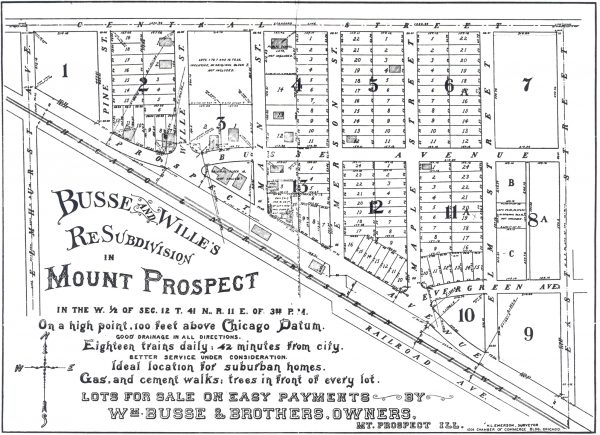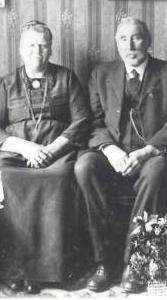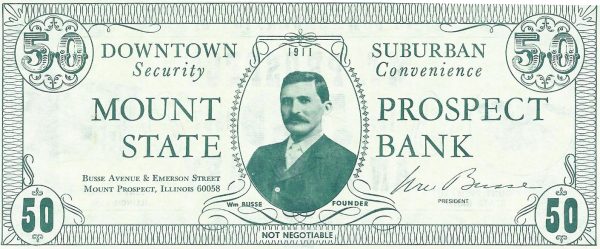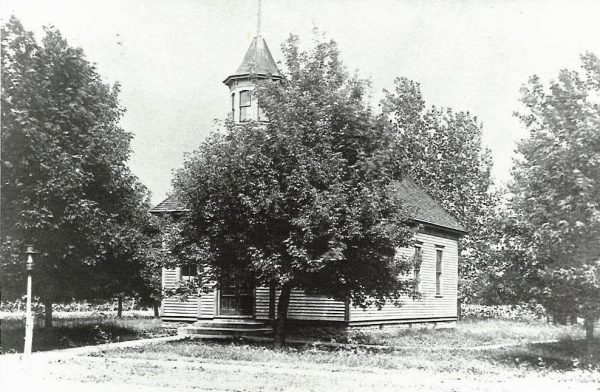
While this description would certainly inspire confidence in the development of the community, it was, unfortunately, ill-timed. The Panic of 1873 (which had until the 1930s been known as “the Great Depression”) dealt severe financial blows to the venture from which Eggleston would not recover, and the project ended in bankruptcy. He is said to have thereafter become a minister. Eggleston’s land was eventually bought up by families remaining in the area such as the Busses, Willes, and Moehlings and became known as “Busse and Wille’s Re-Subdivision in Mount Prospect” by the 1910s. These men formed the Mount Prospect Improvement Association in 1911, and worked towards attracting residents to the Village, as it still lacked the population of 300 needed for official incorporation.
An early map of Mount Prospect boasted that it was an “ideal location for suburban homes, on a high point 100 feet above Chicago Datum” with “good drainage in all directions”. Life in the suburban town would be made easier by “eighteen trains daily, 42 minutes from city” with “better service under consideration”. The developers also took pains let potential buys know that the progressive community also contained “Gas, and cement walks; trees in front of every lot”. The driving force behind the development of the community was man named William Busse, who was by 1900 a Cook County Commissioner and established businessman. However, he had plenty of assistance. Some of his allies included:

John Conrad Moehling – the son of one the earliest settlers of the area. It was reported that his father had been offered two parcels of farmland in what are now the neighborhoods of Lincoln Park and Wicker Park, but did not think them suitable for farming. Moehling had already organized a post office in Mount Prospect at his general store, despite organized opposition from neighboring Des Plaines and Arlington Heights, as well as officially established Mount Prospect’s railroad depot with the Chicago North Western railroad, as “enterprising manager” Eggleston had originally built the depot without consulting railroad officials. It was said that John Conrad was so well-established in the area that now compromises downtown Mount Prospect that it was known informally for many years as “Moehling’s Corners”.

William Wille – William established a creamery, producing milk and cheese, as one of the first businesses in Mount Prospect, known as the Wille Cheese Factory. He abandoned the business after twenty years. His son Albert recalled, “The farmers sold him the milk and he would make butter and cheese and take it into Chicago with a team and wagon. In the spring when the roads were muddy he would often get stuck in a mud hole. Then he would have to unload enough butter and cheese until the team would be able to pull the wagon out of the hole, and then he would reload the load again. He got tired of doing it so often so he closed the creamery and quit the business.” William then used his carpentry skills to become a master builder, constructing many of Mount Prospect’s early buildings, including a tavern and meeting hall that bore his name.
John Meyn – Mount Prospect’s first blacksmith. He was serving as an apprentice in Arlington Heights when he was convinced by Moehling to establish his own shop in Mount Prospect. John’s oldest son Herman would become very involved in Village politics, serving as Mount Prospect second mayor as well as an early ranking member of the Fire Department.
These men and their families knew they were off to a good start by establishing businesses and infrastructure, but there was one thing missing: A public school.
50 years after the formation of the school, around 1950, a local newspaper ran a series of articles of the reminiscences of William Busse, who was at that time well into his 80s, recalling the battle for Mount Prospect’s first public school:
Soon after William Busse became a Mt. Prospect resident, projects for community improvement began to unfold. He admits that enthusiasm on the part of others is sometimes not easy to obtain. When one “hold-backer” asked him, “why don’t you do it,” Bill accepted the challenge and things began to happen… One of the first things they confronted was that here was a town with a railroad station and a post office, but no public school. It was necessary to form the Mt. Prospect school district by carving sections out of five adjoining school districts extending into three townships. It took a lot of convincing to win the assent from the school trustees of three townships.
Locating a site was the next step. William Wille, father of Supervisor Albert Wille owned considerable land on the east side of present Main St. He offered to donate one lot at the southeast corner of Central and Main for school purposes. Mr. Busse inquired what he would charge for one additional lot. The answer was $100. Busse purchased it as his donation. Busse insisted that a total of four lots were needed and Wille agreed to accept $100 for the two extra lots. When the voters were asked to approve the erection of a school building on a site that had been partly donated and the remainder offered at such a low price that the election easily carried.

Two obstacles had been overcome – the district formed and the site purchased. The building came next. Some people thought the original plans were too big. As a compromise they were reduced and the contract let to Mr. Wille, who privately did not think that the building he was told to build was in keeping with a growing community. Wille took his problem to Mr. Busse, who agreed with him that it would be a whole lot better looking school house if it was a little larger. The contractor agreed to stand the extra expense and there would be no additional cost. When the conservative group discovered that a larger building was being erected, fur began to fly. They consulted an attorney who was himself school minded and friendly to Mr. Busse. The attorney told the objectors that the smart thing to do was to allow the contractor to finish the school house and then refuse to pay for it. Before the building was due to be officially accepted time came for a board election. There were two candidates viz: Henry Russell who was admittedly the candidate of the “pros” and Christ Pohlman who was supposedly allied with the objectors.
The Australian ballot system for schools was not then in force. A school election was similar to a mass meeting. Feeling ran high. Fists and canes frequently hit the table. Mr. Pohlman was the winner by one vote. Busse was not discouraged and the evening that the new board was to meet he accidently (sic) on purpose met the new board member on his way to the meeting. The two sat down on the side of the road where Busse told the whole story. At its close Pohlman agreed with William that the town was fortunate to have such a fine school building. The building was accepted as it was built.
When the school board was able to report several years later that the last building bond had been paid, all opposition faded away. Thus the present Mt. Prospect school system had a small beginning, but it is the same spirit displayed today as by the residents of the 1890’s (sic) that has brought about its present fine schools, which don’t seem to be stop growing.

As these images attest, the Central School was quite striking architecturally. Its pitched roof, soaring facade, and intricate trim work make it a fine example of late 19th century Italianate architecture. Its cupola, crowned by eight leaded glass windows give it an imposing, yet dignified, presence. Its four exterior walls are load-bearing. There are no interior structural supports, which demonstrate the ability of the building’s creator, William Wille. Keep in mind that construction took place years before electricity arrived in Mount Prospect. A century later, present-day contractors and architects have remarked on this building’s durability and craftsmanship. The white wooden building was situated at the northeast corner of Central and Main Streets, facing west towards Main Street. The Mount Prospect Public Library currently occupies the site.
Upon its completion, the Central School proved to be a good investment. It served the community in a number of fashions, not only as a center of learning, but as the center of social, political and cultural life. Many of Mount Prospect’s largest community organizations began humbly inside the walls of the schoolhouse…